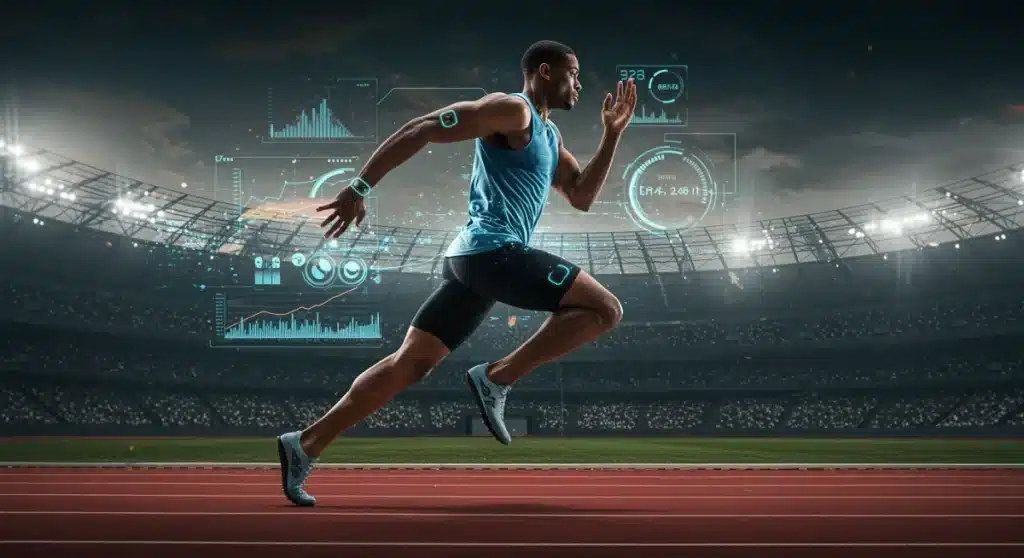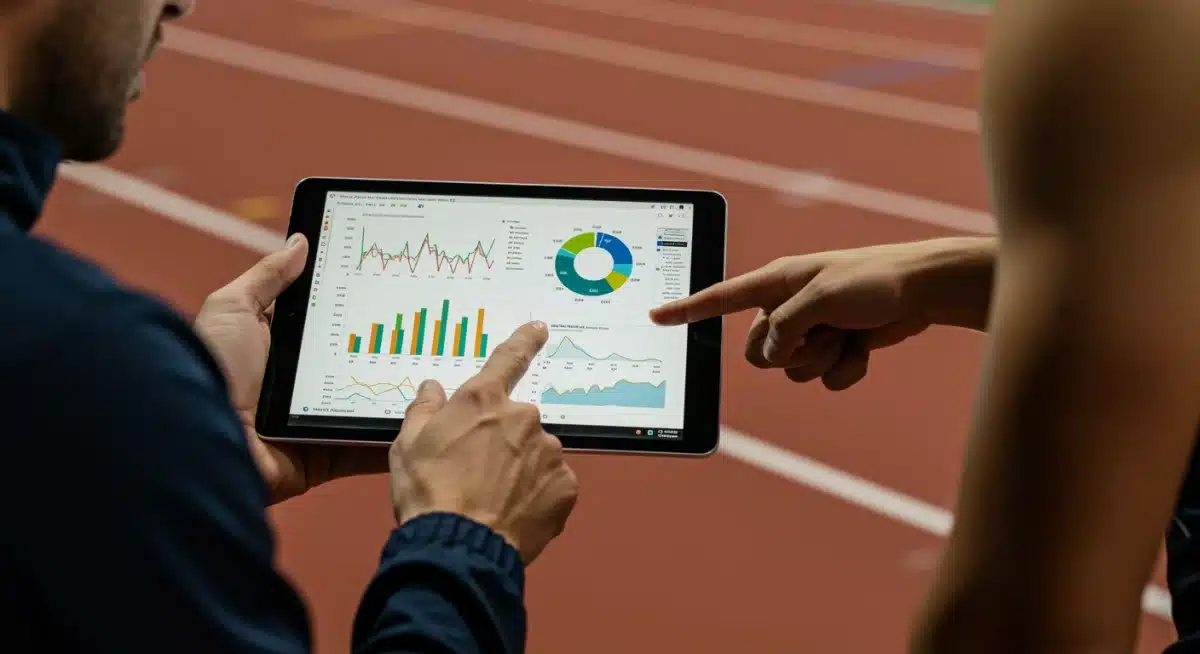New Training Tech to Boost 2025 Track Records

The landscape of elite athletics is rapidly evolving, with new training technologies poised to redefine what’s possible in track and field. As we approach 2025, experts anticipate a surge in record-breaking performances, driven by innovative practical solutions that offer athletes unprecedented insights and optimization tools.
Real-Time Biometric Feedback Revolutionizing Performance
The ability to monitor an athlete’s physiological responses in real time is no longer futuristic; it’s a present-day reality transforming training methodologies. This immediate data allows coaches and athletes to make instantaneous adjustments, optimizing every session for peak efficiency and preventing overtraining.
Advanced wearables and embedded sensors are now commonplace, providing continuous streams of vital metrics. From heart rate variability to muscle oxygenation, these devices paint a comprehensive picture of an athlete’s internal state, allowing for precision in training load management.
Wearable Sensors and Data Integration
Modern wearable sensors are incredibly sophisticated, offering granular data points that were once impossible to track outside of a laboratory setting. These devices seamlessly integrate with centralized platforms, creating a holistic view of an athlete’s progress and recovery.
- Heart Rate Variability (HRV): Provides insights into recovery status and readiness for high-intensity work.
- GPS Tracking: Offers precise data on speed, distance, acceleration, and deceleration during runs.
- Muscle Oxygenation: Measures oxygen levels in active muscles, indicating fatigue onset and optimal effort zones.
- Sleep Tracking: Monitors sleep quality and patterns, crucial for recovery and performance.
The aggregation of this data allows for highly personalized training plans, moving away from generalized approaches to truly individualized programs that adapt to an athlete’s unique physiological responses. This level of personalization is a cornerstone of how new training technologies are impacting track and field.
AI-Powered Analytics and Predictive Modeling for Athletes
Artificial intelligence is no longer just a buzzword in sports; it’s a powerful tool delivering actionable insights and predictive capabilities that were unimaginable just a few years ago. AI algorithms process vast amounts of athlete data, identifying patterns and correlations that human analysis might miss.
This technology can predict injury risks, forecast peak performance windows, and even suggest specific adjustments to technique or diet. The goal is to maximize an athlete’s potential while minimizing downtime, ensuring they are at their best when it matters most.
Optimizing Training Loads with AI
One of the most significant applications of AI in track and field is in optimizing training loads. By analyzing historical performance, recovery data, and biometric feedback, AI models can recommend the ideal intensity and volume for each training session.
This intelligent load management prevents plateaus and overtraining, common pitfalls in high-performance sports. Coaches can now confidently push athletes to their limits, knowing that AI is helping to manage the delicate balance between stress and adaptation.
Furthermore, AI-powered systems can analyze race day conditions and competitor data, providing strategic recommendations that could be the difference between a gold medal and a near miss. The predictive power of these new training technologies is a game-changer.
Advanced Biomechanical Analysis and Virtual Reality Training
Understanding and refining an athlete’s biomechanics is critical for efficiency, power, and injury prevention. New training technologies, particularly advanced motion capture and virtual reality (VR), are providing unprecedented tools for this analysis.
High-speed cameras and markerless motion capture systems can dissect every micro-movement of a sprint, jump, or throw. This precise feedback allows coaches and athletes to identify minute flaws in technique and correct them with surgical precision.
VR for Skill Development and Mental Preparation
Virtual reality is emerging as a powerful tool for skill development and mental conditioning. Athletes can now immerse themselves in realistic competition scenarios, practicing race strategies and visualizing success without the physical toll of actual competition.
- Technique Drills: VR simulations can isolate specific aspects of a movement, allowing for repetitive practice in a controlled environment.
- Race Simulation: Athletes can experience different race scenarios, practicing pacing and strategic decision-making.
- Mental Toughness: VR can expose athletes to high-pressure situations, helping them develop coping mechanisms and maintain focus.
- Injury Rehabilitation: Gamified VR exercises can make rehabilitation more engaging and effective, speeding up recovery.
These immersive experiences, powered by new training technologies, are not just for entertainment; they are serious tools for performance enhancement, offering a safe space to experiment and perfect execution.
Nutrigenomics and Personalized Nutrition Strategies
The adage “you are what you eat” takes on a new scientific dimension with nutrigenomics. This field studies how an individual’s genes interact with nutrients, providing a blueprint for highly personalized dietary strategies that optimize performance and recovery.
No two athletes are exactly alike, and their nutritional needs vary significantly based on their genetic makeup, training load, and specific event demands. Nutrigenomics allows for dietary plans that are tailored down to the molecular level.

Genetic Predisposition and Dietary Interventions
By analyzing an athlete’s genetic profile, nutritionists can identify predispositions to certain deficiencies, sensitivities, or metabolic responses. This information is then used to craft dietary interventions that support optimal health and athletic function.
For example, an athlete with a genetic predisposition to delayed caffeine metabolism might be advised to consume caffeine earlier before an event, or avoid it altogether. Similarly, individuals with specific vitamin absorption issues can receive targeted supplementation.
This precision nutrition, driven by new training technologies, ensures that athletes are fueling their bodies in the most efficient way possible, maximizing energy availability, muscle repair, and overall well-being, which directly translates to improved performance on the track.
Regenerative Therapies and Accelerated Recovery
Recovery is as crucial as training itself, and advancements in regenerative therapies are significantly reducing downtime and accelerating healing for track and field athletes. These cutting-edge treatments are moving beyond traditional methods, offering faster and more complete recovery from injuries and intense exertion.
From advanced cryotherapy chambers to targeted photobiomodulation, these therapies enhance the body’s natural healing processes, allowing athletes to train harder and more consistently.
Innovative Recovery Modalities
The integration of various recovery modalities, often guided by data from other new training technologies, creates a comprehensive recovery strategy. This multi-faceted approach addresses different physiological aspects of recovery.
- Cryotherapy: Full-body or localized cold exposure to reduce inflammation and promote muscle repair.
- Photobiomodulation (Red Light Therapy): Uses specific wavelengths of light to stimulate cellular repair and reduce pain.
- Hyperbaric Oxygen Therapy: Increases oxygen delivery to tissues, accelerating healing and reducing fatigue.
- Compression Therapy: Improves circulation and reduces muscle soreness through controlled pressure.
These interventions are not just for injury treatment; they are increasingly used proactively to manage fatigue and optimize daily recovery, allowing athletes to maintain higher training intensities and volumes, which is a key factor in breaking records.
Smart Equipment and Ergonomic Design
The equipment itself is becoming smarter and more responsive, integrating technology to provide immediate feedback and enhance ergonomic efficiency. From running shoes with embedded sensors to javelins with aerodynamic data collection, every piece of gear is being optimized.
This evolution in equipment design and functionality directly contributes to performance gains, allowing athletes to translate their power and technique into greater speeds, higher jumps, and longer throws.
Responsive Footwear and Track Surfaces
Running shoes are a prime example of smart equipment. Beyond lightweight materials and advanced cushioning, some models now incorporate sensors that analyze gait, foot strike, and ground contact time, providing real-time feedback to the runner.
Similarly, track surfaces are engineered with specific properties to optimize energy return and reduce impact, contributing to faster times and fewer injuries. The interaction between athlete, equipment, and environment is a critical area where new training technologies are making a significant impact.
The continuous innovation in materials science and engineering ensures that athletes are supported by the best possible tools, pushing the boundaries of human performance in every event.
| Key Technology | Impact on Performance |
|---|---|
| Real-Time Biometrics | Enables immediate training adjustments and prevents overtraining, optimizing session efficiency. |
| AI Analytics | Provides predictive insights for injury risk, peak performance, and strategic adjustments. |
| VR Training | Offers immersive simulations for skill refinement, mental preparation, and strategic practice. |
| Personalized Nutrition | Tailors dietary plans based on genetic profiles for optimal fueling and recovery. |
Frequently Asked Questions About Training Technologies
New training technologies break records by enabling hyper-personalized training, real-time physiological monitoring, and precise biomechanical adjustments. This leads to optimized performance, reduced injury risks, and accelerated recovery, allowing athletes to consistently perform at their peak and push past previous limits.
AI analyzes vast datasets to predict injury risks, identify optimal training loads, and forecast peak performance windows. It provides coaches with data-driven insights for strategic planning, ensuring athletes are primed for competition and maximizing their individual potential through intelligent adaptation.
Yes, VR training can simulate high-pressure competition scenarios with remarkable realism. Athletes can practice pacing, strategic decision-making, and visualize success in various race environments, helping them build mental toughness and refine their approach without the physical strain of actual events.
Currently, many cutting-edge new training technologies are more prevalent in elite programs due to cost and infrastructure. However, as the technology matures and becomes more widespread, accessibility is expected to increase, making these tools available to a broader range of athletes and teams.
Personalized nutrition, often guided by nutrigenomics, optimizes an athlete’s fuel intake and recovery based on their unique genetic makeup and physiological demands. This bespoke approach ensures efficient energy utilization, faster muscle repair, and overall enhanced well-being, directly contributing to superior athletic performance.
What This Means
The rapid integration of new training technologies is not merely an incremental improvement; it represents a paradigm shift in track and field. As these advanced tools become more sophisticated and widely adopted, the boundaries of human performance will continue to be pushed. Athletes and coaches who embrace these innovations will gain a significant competitive edge, leading to a new era of record-breaking achievements. The focus will increasingly be on data-driven decisions and individualized approaches, ensuring that every training session contributes optimally to peak performance. Expect to see unprecedented speeds, distances, and heights as 2025 unfolds.





